Plongée sans sel
Menu principal:
- Accueil
- Mises à jour & liens
- janv.-fév. 13
- nov.-déc. 12
- sept.-oct. 2012
- juillet-août 12
- mai-juin 12
- mars-avril 12
- janv.-fév. 12
- nov.-déc. 11
- sept.-oct. 11
- juillet-août 11
- mai-juin 11
- mars-avril 11
- janv.-fév. 11
- nov.-déc. 10
- sept.-oct. 10
- juillet-août 10
- mai-juin 10
- mars-avril 10
- janv.-fév. 10
- nov.-déc. 09
- sept.-oct. 09
- juillet-août 09
- mai-juin 09
- mars-avril 09
- janv.-fév. 09
- nov.-déc. 08
- sept.-oct. 08
- juin-juillet-août 08
- avril-mai 08
- fév.-mars 08
- déc.-janv. 07/08
- oct.-nov. 07
- août-sept. 07
- juin-juillet 07
- avril-mai 07
- un jour de Web
- Découvertes
- avant-propos
- le site
- informatik
- homo sapiens
- rencontres
- remerciements
- ex libris
- God save la France
- Désert américain
- le marché de la faim
- 1952, l'expédition alpine oubliée
- BD, la grande passion
- avant-propos
- La marque jaune
- Le mur de Pan
- Le temps des Lumières
- Universal War
- Le journal de mon père
- Paroles de poilus
- Tango pour un Berliet
- Le photographe
- Pyongyang
- Colt Walker
- Une vie chinoise
- Des nouvelles d'Alain
- L'art vulgaire
- Les longues traversées
- Tintin, on a marché sur la Lune (1954)
- René PELLOS (1900-1998)
- Le pilote aux 2 visages (2012)
- voyages sur la Terre
- pays du Léman
- mobilité douce
- modélisme
- grenier des objets inutiles
- pamphlet
- société de merde
- Plongée
- avant-propos
- souvenirs...
- ex libris
- coups de gueule
- informatique Tok
- musées océanographiques
- plongée lac & rivière
- intro
- ex libris
- Léman (F/CH)
- avant-propos
- bon sens ?
- passé lacustre
- poubelle
- Reposoir (GE)
- Montalègre (GE)
- Montalègre 27juin2012
- crépine des SIG (GE)
- Hermance (GE)
- Hermance 2.3.08
- Hermance 30.3.08
- Hermance 15.11.09
- Hermance, essai UV26 19.09.10
- Hermance, noyez Joël 2010
- Hermance, 17jan2011
- Hermance, réveil 5/11
- Hermance 22avr2012
- Hermance 10juin2012
- panorama du Grand-Lac
- Morges
- Lutry
- Rivaz-gare (Vaud)
- Rivaz-moulin (Vaud)
- Hirondelle (Vaud)
- Hirondelle en Forel (Vaud)
- Hirondelle, 7.2.2009
- château de Chillon (Vaud)
- l'Andalouse (F)
- l'Andalouse - 26.09.10 (F)
- barge d'Yvoire (F)
- bloc erratique de Corzent (F)
- St-Disdille (F)
- St-Disdille 2, le canot
- St-Disdille, 9.3.2008
- St-Disdille, naufrage de la Fraidieu
- Evian, l'Hydronaute (F)
- Evian, barrque à -13m
- Evian, canot à -46m
- Lugrin, débarquadère (F)
- Meillerie I, la carrière (F)
- Meillerie I - 25/9/09
- Meillerie I - 16/5/10
- Meillerie I - 1/08/11
- Meillerie II
- Meillerie II, plongée "zen"
- Meillerie II, l'omblière
- Meillerie, tombant sans nom
- Meillerie, tombant de la Vierge
- Locum, la Neptune (F)
- 19.06.11, s/marins MIR
- lac de Neuchâtel
- Duzillet (CH)
- lac de Joux (CH)
- Valais (CH)
- Arnensee (CH)
- Areuse (CH)
- Constance (CH)
- Hongrin (CH)
- Thun (CH)
- Verzasca (CH)
- Vouglans (F)
- Le Frasnois (F)
- Annecy (F)
- Bourget (F)
- Valserine (F)
- Languedoc (F)
- plongée mer
- plongée tek
- plongée spéléo
- avant-propos
- ex libris
- quel avenir ?
- photographie souterraine
- calculateur JP Couloumy
- Baume des anges (F)
- Denée (B)
- Font Estramar (F)
- Fontaine des Romains (F)
- Fontaine de Vaucluse (F)
- Goul de la tannerie (F)
- Goul du pont (F)
- le Groin (F)
- la Marnade (F)
- Ressel (F)
- St Sauveur
- Yucatan (MX)
- Sardaigne (I)
- ballade en Languedoc
- plongées insolites
- plongée solo/duo
- matos à "bibi"
- entretien courant
- collection
- avant-propos
- plongeur P.I.R.
- Ex libris
- magazine Skin Diver (USA, 1961)
- La Plongée MN (1967)
- Skin diver Bible (USA, 1968)
- le "Molle" (1972)
- Il libro del sub (1977)
- La plongée et l'intervention sous la mer (1977)
- L'école de plongée par l'image (1978)
- Le matériel de plongée sportive (1988)
- the Wakulla springs project (1989)
- plongée en URSS
- Le temps des pionniers (1999)
- accessoires
- scaphandres
- détendeurs
- bouées & stab
- instruments de décompression
- scaph & Cie
- ZP 10, protection NBC
- bonnes adresses
- aqua-dollars
- Recycleur
- accueil
- avant-propos
- ex libris
- de profondis in memoriam
- sécurité & bailout
- lestage
- calculateur Excel de mélange
- spéléo en recycleur
- réunion PUF
- la chaux
- entretien
- contrôler sa PpO2
- les projets
- régénérateur Fenzy-Fernez (1920)
- origine des masques faciaux ARO
- ARO: que faire si vous êtes malade ?
- armement s/marin
- ARO Salvas ('30)
- ARO Pirelli 'Poseidon' ('50)
- Fenzy DC55 (1955)
- ARO Cressi 57b (1957)
- Fenzy Oxygers57 (1957)
- IDA-59 (1959)
- ARO Cressi SUPER ARO ('60)
- Fenzy 55
- Fenzy 63-66
- ARO Cressi Sub ('70)
- ARO OMG Caimano MKI ('70)
- Dräger FGT 1/D (1972-1998)
- Fenzy Mixgers 78 (1978)
- ARO Naubos 88 (1988)
- ARO OMG MK2C (1997)
- Dräger Dolphin (1998)
- MKII (2000)
- ARO OMG Castoro C96 (2002)
- rEvo II (2007)
- accueil
- avant-propos
- j'aime/pas
- rEvo version Ti
- commande puis attente
- présentation générale
- coque inox
- les blocs
- injection O2-diluant
- surcompensation DS4
- tuyaux MP courts
- les 2 filtres
- éponge absorbante
- vidéo: les filtres
- vidéo: les maxi filtres
- contrôleur de Ppo2, le rEvodream
- accessoires sur les flancs
- la stab
- made in 'Ray'
- réglage soupape
- pièces détachées, mon stock
- barre de distribution MP
- tuner sa machine
- BOV JJ-CCR
- rEvo et DSV du Dolphin ?
- Kit WOB II
- plongées rEvo
- spéléo en rEvo
- vidéos rEvo
- fin de l'histoire
- EDO-08 (2008)
- ARO en pvc (2005)
- projet IDOX (2011)
- fabriquer son filtre radial
- mCCR the Monster-ARO (2011)
- mCCR ARO Dakine (2011-2012)
- mCCR RGU-FM
- CCR & Cie
- construire sa machine ?
- recycleur & kayak ?
- Photographie & vidéo
- Occitania
- Genève
- Militaria
- Forum
armement s/marin
Recycleur
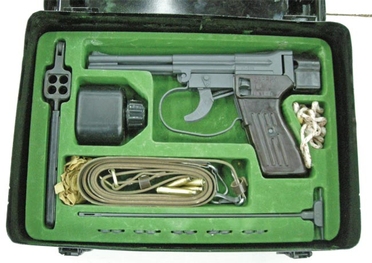
pistolet SSP-1 (Russie)
Pistolet sous-marin lance-fléchettes des forces spéciales russes. Je possède 2 munitions de cette arme plutôt impressionnante. Les fléchettes font 120mm de long.
Type: Double Action Only
Caliber: 4.5x40R
Weight: 950 g empty
Length: 244 mm
Barrel length: 203 mm
Capacity: 4 rounds in separate barrels
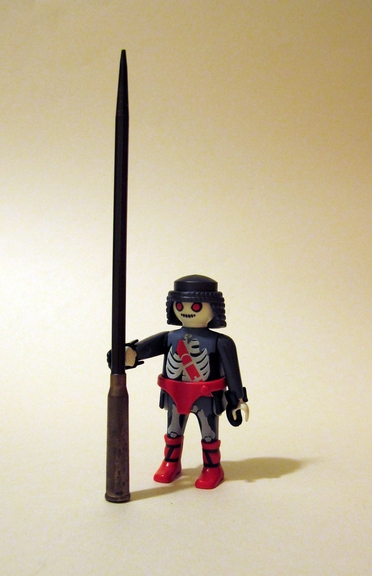
The SPP-1 (Spetsialnyj Podvodnyj Pistolet = Special Underwater Pistol) has been developed in late 1960s by the TSNIITOCHMASH organization on request from the Soviet Navy. The SPP-1 was intended for Soviet combat divers ("frogmen"). Later the SPP-1 has been modified to SPP-1M, with several internal upgrades, and is still used by Russian Navy special forces, as well as offered for export through Russian Governments' military sales organization, RosOboronExport.
SPP-1 is a non-automatic, manually operated handgun with four barrels. Barrels are hinged to the frame in the same manner as on break-open shotguns. For reloading, barrel cluster is tipped to expose chambers, and four cartridges are inserted into barrels. To speed up ejection and reloading cycle, cartridges are loaded using flat clips, made from steel. The double-action trigger unit consists of a striker, mounting on a rotating base, so during the each trigger pull the striker is cocked and simultaneously rotated to the next, unfired barrel. The single lever, located at the left side of the frame, controls the safety and reloading. It has three positions, top for "Reloading" (barrel release), middle for "Safe" and bottom for "Fire".
To be effective underwater, SPP-1 uses special proprietary ammunition, with rimmed bottlenecked cases 40mm long, sealed from water. Unusually long bullets are made from mild steel, and are drag-stabilized underwater; on air, bullets are not stabilized at all, so the effective range "above the air" is limited, but the "lethality range" is about 15 to 20 meters. When underwater, lethality range degrades with the increase of the depth: at 5 meters depth, the effective range is about 17 meters; at 20 meters depth, the effective range is only about 11 meters.
Source: http://world.guns.ru/handguns/hg/rus/spp-1m-underwater-e.html
----------------------------------
Many of us remember the finale in the 1965 movie Thunderball when James Bond and his allies battle Emilio Largo, the evil Number Two of SPECTRE (SPecial Executive for Counter-intelligence, Terrorism, Revenge and Extortion), and his cohorts, in the massive underwater battle scene where the main battle implements were knives and elastic powered or compressed gas spear guns. Though that book, film and battle was fictitious, war beneath the waves isn’t.
The Russian company Tsniitochmash, the Central Scientific Research Institute of Precise Mechanical Engineering, located in the Moscow Region, has produced two firearms for the underwater warrior: the 4.5mm SPP-1M underwater pistol and the 5.66mm APS underwater assault rifle.
Surprisingly, these are not new weapons as they were developed and put in Russian service over thirty years ago. They are excellent examples of the secrecy that surrounded the Soviet Union and were unknown, even at classified levels, in the West until Tsniitochmash began offering them publicly in 1993.
Developed in the late 1960s at the request of the Soviet Navy and accepted in 1971, the 4.5mm SPP-1 (Spetsialnyi Podvodnyi Pistolet – Special Underwater Pistol) was designed to arm combat divers (frogmen). Later, the SPP-1 was upgraded to the SPP-1M that was basically the same pistol but had an extra spring above the sear to improve trigger pull and had a larger trigger guard to accommodate the use of diving gloves. It is still in use by Russian Navy Special Forces.
The SPP-1M underwater pistol is a manually operated handgun that consists of four smoothbore barrels grouped in a square cluster. The barrel cluster is hinged to the frame just in front of the trigger guard and breaks open in a similar fashion as a break-open shotgun. There is a single striker (firing pin) and the double action firing mechanism fires one cartridge sequentially each time the trigger is pulled. The striker is mounted on a rotating base and with each pull of the trigger the striker is cocked and simultaneously rotated to the next, unfired barrel.
The pistol uses a proprietary 4.5mm SPS pistol cartridge that has high penetrating power by replacing the typical bullet with a metal dart. Underwater, conventional bullets are highly ineffective being inaccurate and limited to a very short range with a rapidly decreasing lethality. The “bullet” has been replaced with a long 115mm (4.53 inches) dart weighing 12.8 grams (.452 oz.) made from mild steel that has a slightly flattened tip. The fired projectile is kept stabilized by using a hydrodynamic cavity that is generated by the flattened point of the projectile that results in reduced drag, increased accuracy and lethality. The dart has a longer range and more penetrating power than speargun spears. The cartridge is a rimmed bottleneck case 40mm (1.575 in.) long and sealed against water. The complete cartridge is 145mm (5.71 in.) long and weighs 17.5 grams (.617 oz.).
The pistol is loaded with four cartridges at a time that are held together as a group by a clip in the same square arrangement as the barrels. The pistol is broken open and the clip containing the four SPS cartridges are inserted into their respective chambers. The action is closed and the pistol is ready to fire. There is a single lever with three position options located on the left side of the frame at the top of the pistol grip, just behind the trigger, that controls the operation of the pistol. The top position is for “Reloading” (barrel release), the middle position is “Safe” and the bottom position is “Fire.”
The pistol can be fired out of the water in the air environment. Due to the pistol being smoothbore and firing a dart, the projectile is not stabilized at all and accuracy is greatly affected with an effective lethality range of 15-20 meters. In an emergency, at very close range, it is still highly effective.
Range and lethality underwater changes the deeper the diver goes. Depth reduces the range because the deeper one goes there is more water pressure that closes the hydrodynamic cavity sooner. Once the projectile is no longer supercavitating, the hydrodynamic drag increases greatly resulting in the projectile becoming unstable. The manufacturer claims that at a depth of 5 meters (16.4 ft.), the lethality range is 17 meters (55.17 ft.); at a depth of 20 meters (65.62 ft.), the lethality range is 11 meters (36.09 ft.) and at a depth of 40 meters (131.23 ft.), the lethality range is 6 meters (19.69 ft.). Its stated lethal range is the range from which it can easily penetrate a padded underwater Prolon diving suit (flexible polyurethane padding) or a 5mm thick organic glass face mask.
The SPP-1M underwater pistol comes complete in a metal storage case that includes the pistol, ten cartridge clips, a holster that can attach to a diver’s belt, a device for loading the SPS cartridges into the clips, a special sling to carry the pistol and three combat ready metal quivers that each hold a set of four loaded SPS cartridges in their clips that the diver can attach to his dive belt. Thus, the combat load is four rounds in the gun and twelve at the ready.
Source: http://sadefensejournal.com/wp/?p=512
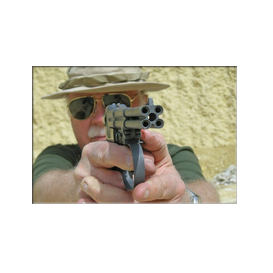

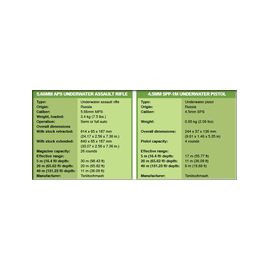
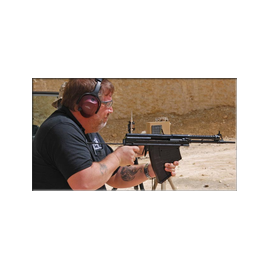
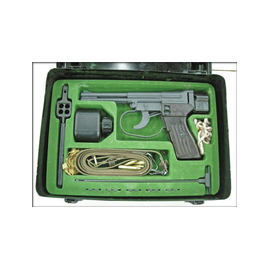
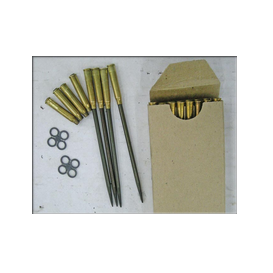
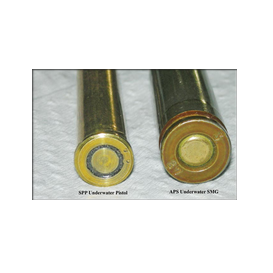
Sous-menu
- accueil
- avant-propos
- ex libris
- de profondis in memoriam
- sécurité & bailout
- lestage
- calculateur Excel de mélange
- spéléo en recycleur
- réunion PUF
- la chaux
- entretien
- contrôler sa PpO2
- les projets
- régénérateur Fenzy-Fernez (1920)
- origine des masques faciaux ARO
- ARO: que faire si vous êtes malade ?
- armement s/marin ←
- ARO Salvas ('30)
- ARO Pirelli 'Poseidon' ('50)
- Fenzy DC55 (1955)
- ARO Cressi 57b (1957)
- Fenzy Oxygers57 (1957)
- IDA-59 (1959)
- ARO Cressi SUPER ARO ('60)
- Fenzy 55
- Fenzy 63-66
- ARO Cressi Sub ('70)
- ARO OMG Caimano MKI ('70)
- Dräger FGT 1/D (1972-1998)
- Fenzy Mixgers 78 (1978)
- ARO Naubos 88 (1988)
- ARO OMG MK2C (1997)
- Dräger Dolphin (1998)
- MKII (2000)
- ARO OMG Castoro C96 (2002)
- rEvo II (2007)
- EDO-08 (2008)
- ARO en pvc (2005)
- projet IDOX (2011)
- fabriquer son filtre radial
- mCCR the Monster-ARO (2011)
- mCCR ARO Dakine (2011-2012)
- mCCR RGU-FM
- CCR & Cie
- construire sa machine ?
- recycleur & kayak ?